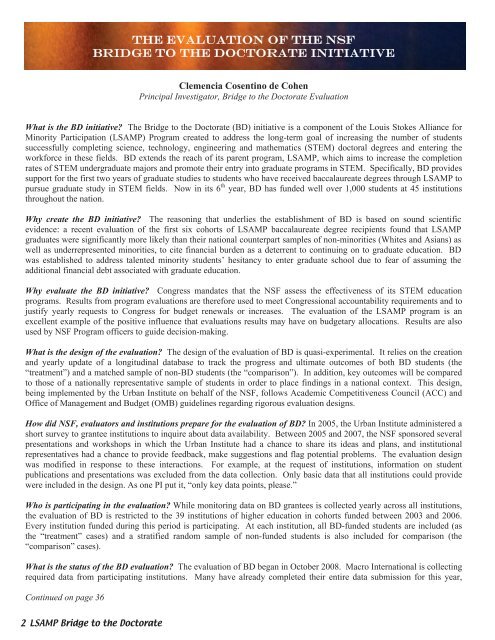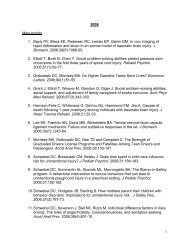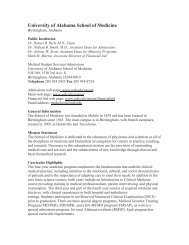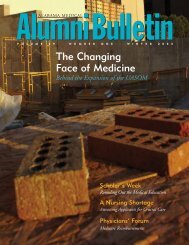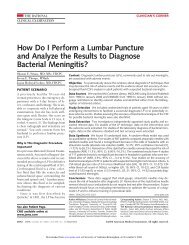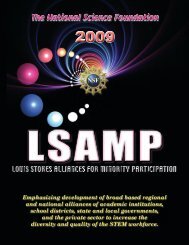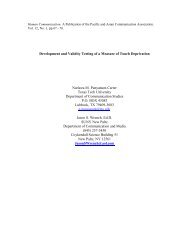15527 BD Magazine '09.indd - University of Alabama at Birmingham
15527 BD Magazine '09.indd - University of Alabama at Birmingham
15527 BD Magazine '09.indd - University of Alabama at Birmingham
You also want an ePaper? Increase the reach of your titles
YUMPU automatically turns print PDFs into web optimized ePapers that Google loves.
The Evalu<strong>at</strong>ion <strong>of</strong> the NSF<br />
Bridge to the Doctor<strong>at</strong>e Initi<strong>at</strong>ive<br />
Clemencia Cosentino de Cohen<br />
Principal Investig<strong>at</strong>or, Bridge to the Doctor<strong>at</strong>e Evalu<strong>at</strong>ion<br />
Wh<strong>at</strong> is the <strong>BD</strong> initi<strong>at</strong>ive? The Bridge to the Doctor<strong>at</strong>e (<strong>BD</strong>) initi<strong>at</strong>ive is a component <strong>of</strong> the Louis Stokes Alliance for<br />
Minority Particip<strong>at</strong>ion (LSAMP) Program cre<strong>at</strong>ed to address the long-term goal <strong>of</strong> increasing the number <strong>of</strong> students<br />
successfully completing science, technology, engineering and m<strong>at</strong>hem<strong>at</strong>ics (STEM) doctoral degrees and entering the<br />
workforce in these fields. <strong>BD</strong> extends the reach <strong>of</strong> its parent program, LSAMP, which aims to increase the completion<br />
r<strong>at</strong>es <strong>of</strong> STEM undergradu<strong>at</strong>e majors and promote their entry into gradu<strong>at</strong>e programs in STEM. Specifically, <strong>BD</strong> provides<br />
support for the first two years <strong>of</strong> gradu<strong>at</strong>e studies to students who have received baccalaure<strong>at</strong>e degrees through LSAMP to<br />
pursue gradu<strong>at</strong>e study in STEM fields. Now in its 6 th year, <strong>BD</strong> has funded well over 1,000 students <strong>at</strong> 45 institutions<br />
throughout the n<strong>at</strong>ion.<br />
Why cre<strong>at</strong>e the <strong>BD</strong> initi<strong>at</strong>ive? The reasoning th<strong>at</strong> underlies the establishment <strong>of</strong> <strong>BD</strong> is based on sound scientific<br />
evidence: a recent evalu<strong>at</strong>ion <strong>of</strong> the first six cohorts <strong>of</strong> LSAMP baccalaure<strong>at</strong>e degree recipients found th<strong>at</strong> LSAMP<br />
gradu<strong>at</strong>es were significantly more likely than their n<strong>at</strong>ional counterpart samples <strong>of</strong> non-minorities (Whites and Asians) as<br />
well as underrepresented minorities, to cite financial burden as a deterrent to continuing on to gradu<strong>at</strong>e educ<strong>at</strong>ion. <strong>BD</strong><br />
was established to address talented minority students’ hesitancy to enter gradu<strong>at</strong>e school due to fear <strong>of</strong> assuming the<br />
additional financial debt associ<strong>at</strong>ed with gradu<strong>at</strong>e educ<strong>at</strong>ion.<br />
Why evalu<strong>at</strong>e the <strong>BD</strong> initi<strong>at</strong>ive? Congress mand<strong>at</strong>es th<strong>at</strong> the NSF assess the effectiveness <strong>of</strong> its STEM educ<strong>at</strong>ion<br />
programs. Results from program evalu<strong>at</strong>ions are therefore used to meet Congressional accountability requirements and to<br />
justify yearly requests to Congress for budget renewals or increases. The evalu<strong>at</strong>ion <strong>of</strong> the LSAMP program is an<br />
excellent example <strong>of</strong> the positive influence th<strong>at</strong> evalu<strong>at</strong>ions results may have on budgetary alloc<strong>at</strong>ions. Results are also<br />
used by NSF Program <strong>of</strong>ficers to guide decision-making.<br />
Wh<strong>at</strong> is the design <strong>of</strong> the evalu<strong>at</strong>ion? The design <strong>of</strong> the evalu<strong>at</strong>ion <strong>of</strong> <strong>BD</strong> is quasi-experimental. It relies on the cre<strong>at</strong>ion<br />
and yearly upd<strong>at</strong>e <strong>of</strong> a longitudinal d<strong>at</strong>abase to track the progress and ultim<strong>at</strong>e outcomes <strong>of</strong> both <strong>BD</strong> students (the<br />
“tre<strong>at</strong>ment”) and a m<strong>at</strong>ched sample <strong>of</strong> non-<strong>BD</strong> students (the “comparison”). In addition, key outcomes will be compared<br />
to those <strong>of</strong> a n<strong>at</strong>ionally represent<strong>at</strong>ive sample <strong>of</strong> students in order to place findings in a n<strong>at</strong>ional context. This design,<br />
being implemented by the Urban Institute on behalf <strong>of</strong> the NSF, follows Academic Competitiveness Council (ACC) and<br />
Office <strong>of</strong> Management and Budget (OMB) guidelines regarding rigorous evalu<strong>at</strong>ion designs.<br />
How did NSF, evalu<strong>at</strong>ors and institutions prepare for the evalu<strong>at</strong>ion <strong>of</strong> <strong>BD</strong>? In 2005, the Urban Institute administered a<br />
short survey to grantee institutions to inquire about d<strong>at</strong>a availability. Between 2005 and 2007, the NSF sponsored several<br />
present<strong>at</strong>ions and workshops in which the Urban Institute had a chance to share its ideas and plans, and institutional<br />
represent<strong>at</strong>ives had a chance to provide feedback, make suggestions and flag potential problems. The evalu<strong>at</strong>ion design<br />
was modified in response to these interactions. For example, <strong>at</strong> the request <strong>of</strong> institutions, inform<strong>at</strong>ion on student<br />
public<strong>at</strong>ions and present<strong>at</strong>ions was excluded from the d<strong>at</strong>a collection. Only basic d<strong>at</strong>a th<strong>at</strong> all institutions could provide<br />
were included in the design. As one PI put it, “only key d<strong>at</strong>a points, please.”<br />
Who is particip<strong>at</strong>ing in the evalu<strong>at</strong>ion? While monitoring d<strong>at</strong>a on <strong>BD</strong> grantees is collected yearly across all institutions,<br />
the evalu<strong>at</strong>ion <strong>of</strong> <strong>BD</strong> is restricted to the 39 institutions <strong>of</strong> higher educ<strong>at</strong>ion in cohorts funded between 2003 and 2006.<br />
Every institution funded during this period is particip<strong>at</strong>ing. At each institution, all <strong>BD</strong>-funded students are included (as<br />
the “tre<strong>at</strong>ment” cases) and a str<strong>at</strong>ified random sample <strong>of</strong> non-funded students is also included for comparison (the<br />
“comparison” cases).<br />
Wh<strong>at</strong> is the st<strong>at</strong>us <strong>of</strong> the <strong>BD</strong> evalu<strong>at</strong>ion? The evalu<strong>at</strong>ion <strong>of</strong> <strong>BD</strong> began in October 2008. Macro Intern<strong>at</strong>ional is collecting<br />
required d<strong>at</strong>a from particip<strong>at</strong>ing institutions. Many have already completed their entire d<strong>at</strong>a submission for this year,<br />
Continued on page 36<br />
2 LSAMP Bridge to the Doctor<strong>at</strong>e


